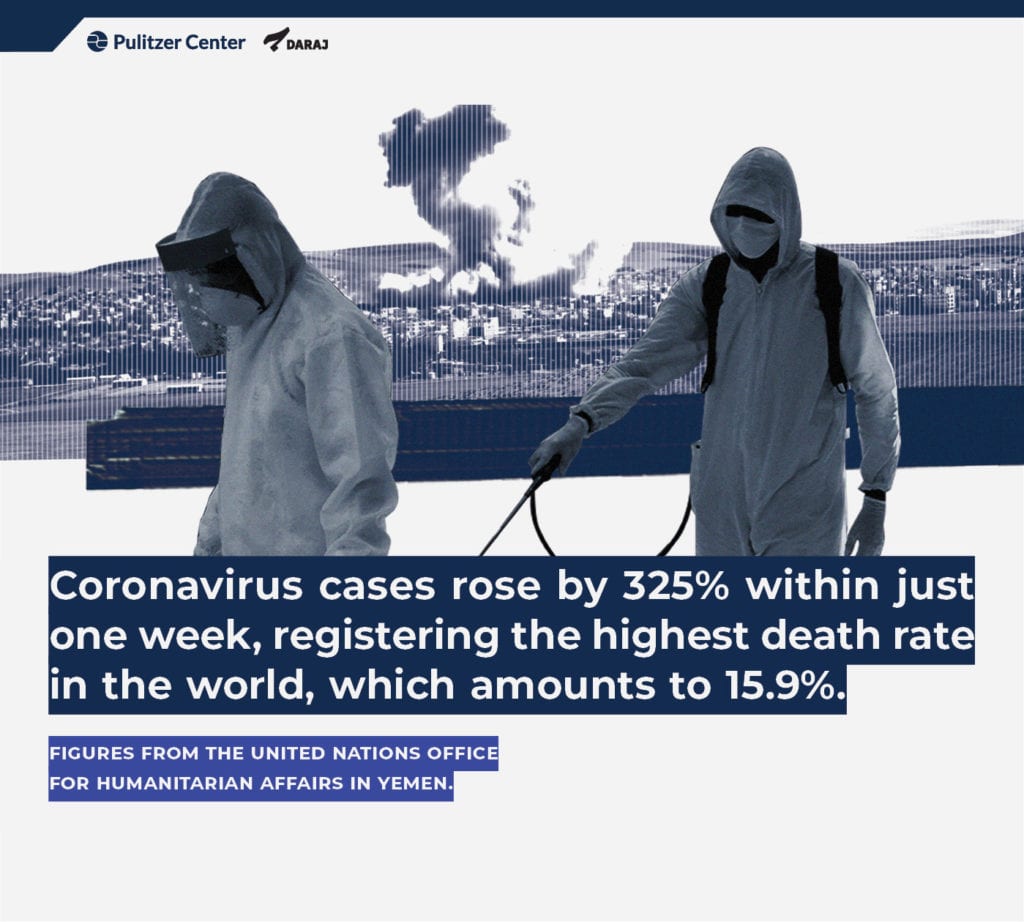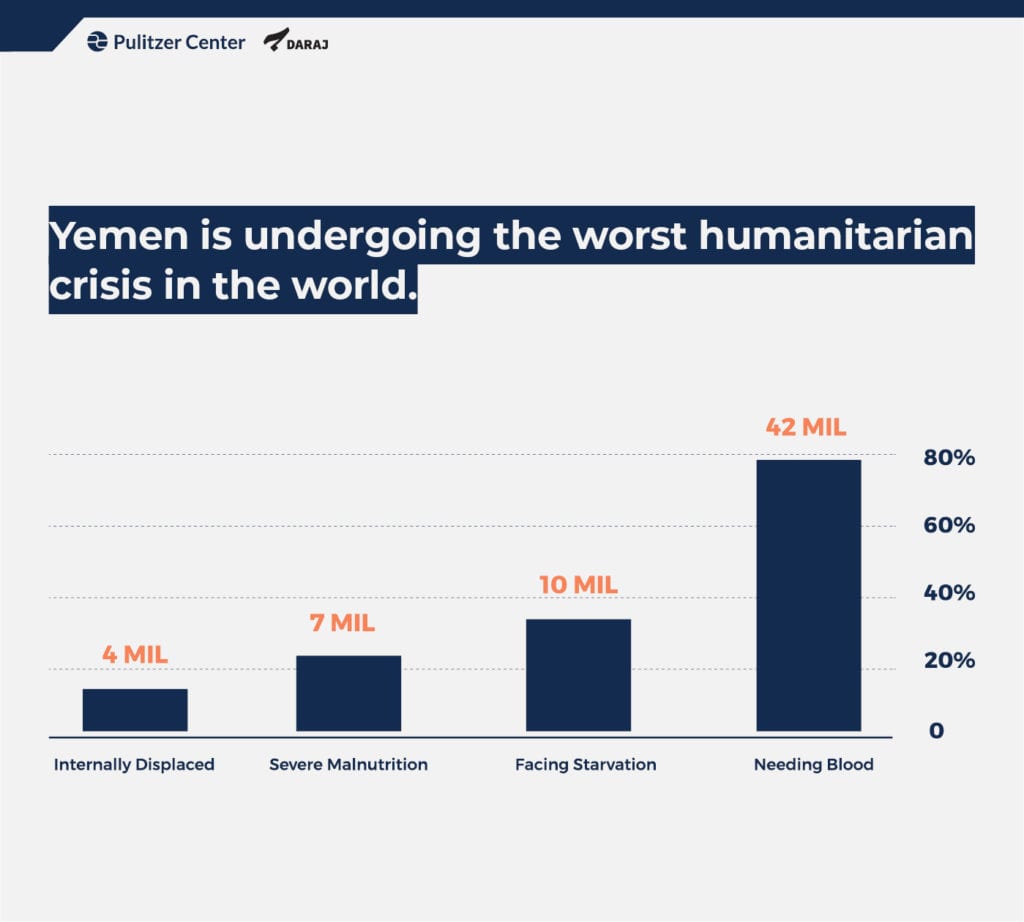This topic has been prepared in cooperation with Pulitzer Center.
On May 30, Yemeni Ahmed Al-Qaari published a cry for help on his Facebook page in which he said: “My dad is dying, and all the hospitals have refused his admission.” On June 1st, he wrote: “My dad died.”
In a few words, he summarized the suffering of the hundreds of thousands of Yemenis who are dying, of both known and unknown reasons, in light of the almost total absence of medical care that has been worsened by the outbreak of “COVID-19” in the country.
On April 10th, the first case of COVID-19 was confirmed in the Hadramaut Governorate, in eastern Yemen, contracted by a citizen in his sixties. Later on April 27th, the Supreme Medical Committee announced the recovery of the case without mentioning any details regarding Yemen’s case zero, except for some circulating media reports that suggested that the patient’s infection was a result of contact with workers on shipping boats that came from neighboring countries. During the next few days, the situation aggravated in Aden, 656 km from Hadramaut, where dozens of cases began to be confirmed in record time, and while the real numbers were even more shocking.
The majority of the conflicts, events, and diseases in Yemen, including COVID-19, are still unknown not only to the outside world, but even to Yemenis in their homes. This comes as a result of the absence of the state, acute political divisions, the dominance of propaganda discourse over the accountable national media discourse, the same discourse which served to establish war as a natural case..
The graves of the city began to be crowded by dozens of corpses with the symptoms experienced by those who died, largely resembling those associated with the Coronavirus. A widespread debate was launched, about the causes of all these deaths.
“Doctors Without Borders” expressed that the deaths could be a result of the pneumonic plague in the city, after some floods occurred in the streets causing severe human and material damage. The authorities, represented by Dr. Adham Awad, Director General of Disease Control and Epidemiological Surveillance in the internationally recognized and legitimate government, denied this and stressed that fever and epidemics have increased due to the rain and torrents accompanied by sewage rashes and rubbish piles, especially since they were already present in many of the Yemeni cities, the most important of which are Aden, Taiz and Hudaydah. However, it was established that the number of deaths increased sevenfold in Aden. According to what the head of the Civil Registration Authority, Major General, Sanad Jameel, told to “Aden Al-Ghad” newspaper, the authority issued 73 burial permits on Sunday May 10th only.
The first case in Taiz, the most densely populated city, was confirmed on May 1. On May 5, the Capital, Sanaa, followed after the Houthis announced the first patient who was a Somali migrant who passed away before the Health Minister of Sanaa even announced his infection.

Catastrophe Triggers
Yemen is suffering from the worst humanitarian crisis ever, due to the war that has been going for more than five years. The United Nations estimated that 80% of the population, that is 24 million Yemenis, need support and humanitarian aid, 10 million Yemenis are a step away from starvation, 7 million Yemenis are suffering from acute malnutrition. Meanwhile, the number of those who are internally displaced exceeds 4 million, according to the UNHCR. The lucky displaced ones live in camps supervised by the agency, but large numbers of them, estimated at hundreds of thousands, are displaced in irregular places.


In parallel with this situation, more than a million employees in the governmental civilian sector live in Houthi-controlled areas, without salaries since September 2016. About 30 thousand of those employees form a large proportion of the field employees of the health sector, which represents only 42% of the governmental sector due to the migration of large numbers of doctors for reasons that are not limited to material factors, but also related to the structure of the Yemeni political system over the last few decades. The successive crises since 2011 contributed to aggravating those reasons, according to Dr. Mohammed Azab, head of the department of immunity and viruses at the University of Science and Technology Hospital.
Then came the Coronavirus to cause the death of 53 persons, from this already dilapidated staff, from April to June 25, 2020. While dozens of those personnel are still in the medical quarantine facilities, a statistic that may not match reality as well due to the way society deals with the epidemic as if it was some sort of a crime. This drove the families of the doctors to hide the cause of the infection or death, in order to avoid the “Coronavirus” stigma.
Al-Azab indicated that the doctors’ repeated infection due to being in continuous contact with the patients is a main reason for the increased infection rate within the medical community. He also warned that the hospitals in their current condition may turn into dangerous centers of infection outbreak.
Coronavirus worsens the complexities and difficulties of the work of the medical staff and adds additional challenges to the previously existing ones they used to face with minimum capabilities. This is especially after the Cholera epidemic broke out in more than 20 governorates, causing 112,851 suspected cases and 56 laboratory confirmed cases, and 29 deaths between January and May 2020.
Also, dengue fever has afflicted approximately 3,500 people and claimed 50 lives in Al Hudaydah Governorate only in the same period, while cases of the Chikungunya infection have not been recorded in the statistics of the Disease Control and Epidemiology Unit, despite the appearance of dozens of infected cases.


“Coronavirus” Is a Trump Card Used in Wars
On a related level, mass media and officials in Sanaa were promoting the idea that Yemen is safe from the grip of the epidemic due to the blockade imposed on Yemen and the interruption of tourism, economy and movement with the rest of the world. The Foreign Ministry’s advisor of the Houthi authority went further by doubting the existence of the virus in the first place, and calling on the Yemenis to “head to the battlefields, instead of dying by Coronavirus”, sarcastically. However, the epidemic did not grant him a respite even to participate in the battlefield as he died by the virus very soon after his statements.
Concurrently, people have started talking about the spread of the epidemic in the rural and remote areas, which lack the most basic health services, while the complete media blackout concerning the infection statistics continues, with the exception of a press conference on May 29. At the conference, Sanaa’s Health Minister, Taha al-Mutawakkil, stated that the swabs and solutions sent by the World Health Organization are inaccurate. These swabs have shown positive results for non-human samples. This revealed a gap that seemed crystal- clear between Sanaa and the World Health Organization, even though they apparently are still in cooperation.


The history of the gap goes back to earlier times, specifically the end of 2019 when a mysterious disease spread in numerous cities controlled by Houthis. The significant symptoms of that disease included headache, fever, dry cough and shortness of breath (dyspepsia). Health authorities used to call it “Viral Fever” in case the patient was not tested H1N1 positive. The mentioned symptoms invaded vast areas; including a village in Bani Al- Dhubaibi area, Raymah governorate, where all the residents suffered from the same disease collectively without getting the attention of the concerned authorities, despite the continuity of the disease from one and a half weeks to three weeks, during which the people resorted to treatment using herbs and natural materials. In addition, Dr. Rania Jaashan, a specialist in intensive care and anesthesiology, at the Kuwait Government Hospital in Sanaa, which was designated by Sanaa Authority to treat “Coronavirus” cases, emphasized that viral pneumonia cases have spread widely during that period. Dr. Rania personally dealt with two of the viral pneumonia cases who died just two weeks after they were rushed to the hospital. The cases were rapidly deteriorating; and surprisingly, most of the viral pneumonia deaths were among the 20 to 25 age group.
It is believed that the disease has killed 271 people out of the 6,945 registered cases, according to Sanaa’s Ministry of Health report entitled “The Epidemiological Situation of the Cases of Severe Acute Respiratory Infections”.
Field conditions have badly and mysteriously aggravated the health conditions in Yemen, supporting the tweet made by the United Nations Office for Humanitarian Affairs in Yemen on May 21 which stated that the rapid rise in cases of COVID-19 in Yemen resulted from its spread for weeks before cases were detected.
The United Nations Office reported the rise of the cases by 325 percent within just one week, registering the highest death rate in the world, which amounted to 15.9 percent. This was contributed to by the lack of transparency among the Houthis in the north, and the lack of enough medical primary materials such as oxygen pipes, vitamin C, and medications such as Paracetamol in pharmacies. Citizens are accusing the authorities of confiscating those medications in favor of the quarantine centers allocated to treat “Coronavirus” cases.
On the other hand, the Transitional Council’s conflict in the south with the internationally recognized legitimacy presented a stumbling block to the arrival of medical equipment and tools to the regions and entities which need support. Moreover, the detention of the medical shipments that arrived from abroad at the Aden airport at the hands of the Transitional Council’s fighters who are seizing the airport, and the disappearance of 30,000 test strips coming from China through Jeddah airport, with which officials from the Yemeni consulate in Jeddah and members of the Health Ministry of the Legitimacy were charged, constituted additional obstacles to confronting COVID-19. Official statistics of the epidemic recorded 2828 suspected cases and 1089 confirmed infectious cases till Friday, June 26, with a total death rate of 293 and a total recovery rate of 402 cases. These statistics include the southern governorates and Taiz only, while there are no statistics on the northern governorates, except for estimates monitored by Dr. al-Azab, which are likely indicating that the total number of infections in Sanaa has exceeded 100,000 cases, with the situation likewise in Taiz, and more than 70,000 cases in Dhamar and the same in Ibb. These estimates are based on comparisons and approaches that have been linked to the population density in these cities, and with regard to the failure of the authorities to implement the necessary preventive measures before and during the outbreak of the pandemic.
To conclude, the majority of the conflicts, events, and diseases in Yemen, including COVID-19, are still unknown not only to the outside world, but even to Yemenis at their homes as a result of the absence of the state, acute political divisions, the dominance of propaganda discourse over the accountable national media discourse, the discourse which served to establish war as a natural case, and then by the fragility of the chronic health sector. Accordingly, there are seriously dangerous hidden dimensions in the absence of real information related to the breakout of the pandemic in Yemen. The consequences will not only affect Yemen but its impact may also include other places in the future, especially with the “World Health Organization” warning that the world will face a new and dangerous stage of the epidemic.






